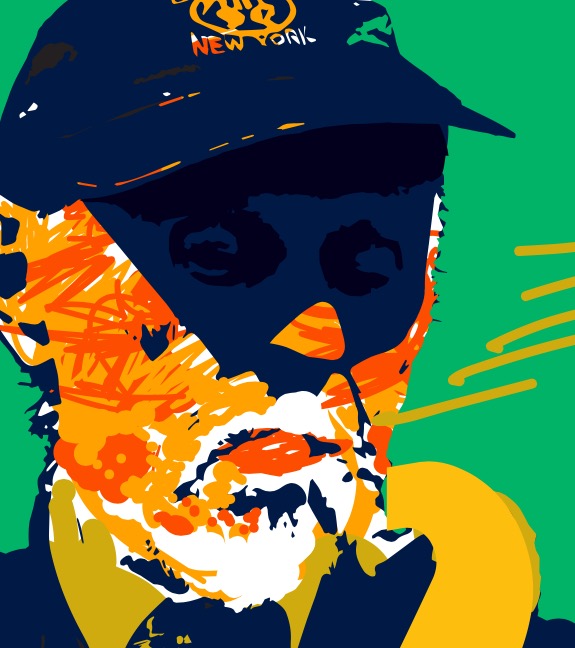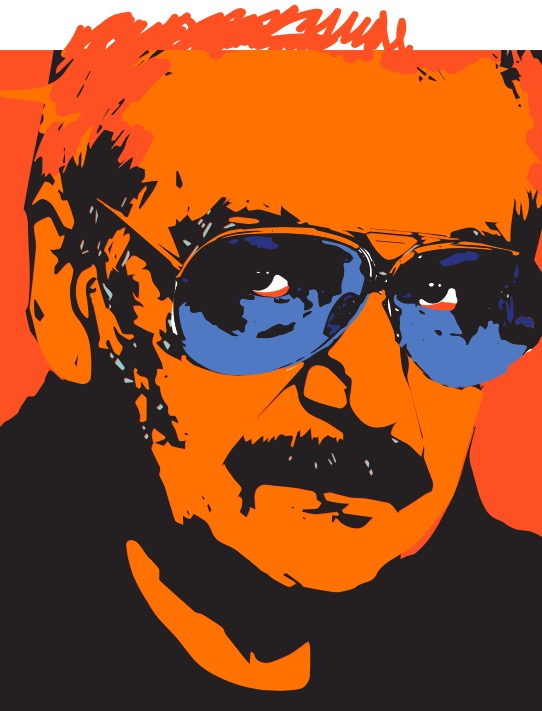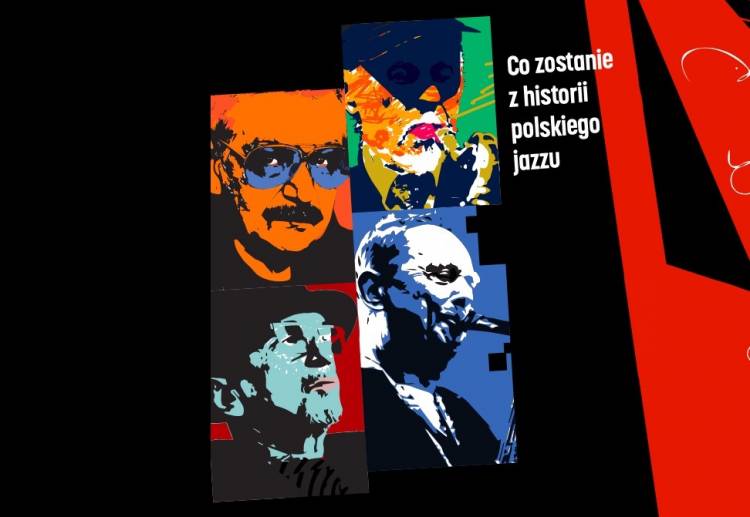design by Andrzej Wąsik
Author: Jakub Krukowski
“I have one answer: the truth. It was so true to the point of being naive” – Michał Urbaniak explained his success. What could Polish artists bring into the music, the roots of which grew from cultures that were completely foreign to them? The authenticity mentioned by the violinist seems to be the most prosaic input, however it turns out to be truly valued. Joachim-Ernst Berendt sets the incredibly significant book The Jazz Book, writing: “Jazz was always the case of a minority.” It is tough not to agree with this viewpoint, when one is getting to know the history of development of the genre in Poland. The local environment had always shown strength when it had to react to the changing reality. It survived, because, in every step of the way, as said Urbaniak, it remained so true to the point of being naïve.
In Poland, jazz gained popularity in the interwar period, mainly due to the film industry. Our country also became a shelter for Jews fleeing nationalist tendencies, including the most important trumpeter of that period, Adolf Rosner. The outbreak of World War II stopped the genre's development, bringing many artists to death or forcing them to emigrate. After 1945, the surviving scraps of the jazz world, instead of reviving their achievements, encountered a new system, the ideology of which ruled out the existence of such music. Nobody expected that the manifestations of artistic activity, demanding the right to independence, would become part of the democratic processes.
Melodics & Hołgi-Volga
As a contradiction of top-down canons, playing jazz in communism turned out to be an excellent means of expressing difference. Undoubtedly, the 1st National Jazz Music Festival in Sopot was a milestone for the identity of the genre in this part of Europe. Opening the event on August 6, 1956, Leopold Tyrmand, the spiritus movens of popularizing the trend, announced: “At the moment (…) jazz is already a great epoch in the history of music (…), because it expresses the joys and sorrows of our generation (…). Maybe a bit too noisy, but what can we do if this whole twentieth century (...) is noisy ".
Music, as it is used to say, "came out of the catacombs", and the names of Komeda, Kurylewicz, Ptaszyn Wróblewski and Milian made their way into the general consciousness. The events that took place in Sopot brought back the feeling of forgotten freedom, which was later repeated by the Jarocin festival. Michał Urbaniak rightly stated that by letting jazz into the country, the authorities undermined the foundations of the system. The oppressive regime was not the only factor motivating the development of beginning musicians. For those who were inculcated in traditionalist schools, as Jerzy Milian recalls, "melodics and hołgi-volga [boogie-woogie] have nothing to do with real art", the discovery of jazz gave a chance to express oneself.
Chopin’s Legacy
No matter in which corner of the world you ask about your knowledge of Polish music, you can expect the answer to mention Fryderyk Chopin. Its greatness, however, is not evidenced by its popularity as well as its legacy. “Chopin cannot be avoided by playing anything. (…) Being inspired by Chopin or his work is something different than playing his compositions, ”claims Tomasz Stańko. Leszek Możdżer called the pianist the greatest improviser of his time, adding that "if he were alive today, he would be a jazz musician".
Krzysztof Komeda, the precursor of modern jazz in his homeland, also saw strong connections between his style and the achievements of the 19th-century composer. At the same time, he pointed to the aesthetics that were peculiar to him, which permanently adhered to his successors: “I grew up on the Romantics, and especially on Chopin. There is a lot of talk (...) about the lyricism of my music. I think I am actually succumbing to this universal tendency of Poles. "
In 1966, the Komeda Quintet recorded probably the most important album for the jazz community. Astigmatic impresses with its innovative approach to form, expanding the way of thinking about the genre. "By the strength of his personality, he convinced Komeda about the need to master the emotional area previously reserved for the great symphonic works," wrote Adam Sławiński. The album entered the canon as a symbol of the Polish jazz school, defining its characteristic Slavic idiom. Komeda also participated in the creation of European cinematography, composed soundtracks to 65 films. Had it not been for a fatal accident, his career could have elevated him to a level so far unattainable for Polish jazzmen.
Mieczysław Kosz presented a special example of the romantic trend in pianism. He called his work "mood painting", which perfectly reflects the spirit of his sensitive nature. This brilliant musician, despite his total blindness, proved to be an extraordinarily talented pianist.
From the position of the "new face" of the Polish scene, he quickly grew into its important representative, and after his performance at the festival in Montreux, the press enthusiastically compared him with Bill Evans.
 [Jan Ptaszyn Wróblewski, design by Andrzej Wąsik]
[Jan Ptaszyn Wróblewski, design by Andrzej Wąsik]
For Kosz, a particularly important element of the repertoire was the Chopin Prelude in C minor, placed on the debut album Reminiscence from 1972. When describing the piece, Krystian Brodacki noticed that you need "great culture and intuition to respect the great prototype". Kosz has shown true mastery in this matter. Unfortunately, also in this case, a personal tragedy sharply interrupted the artist's promising career.
Attempts at a jazz interpretation of the composer's repertoire in later years turned out to be equally beneficial in both the artistic and commercial dimensions. The first, and at the same time the greatest success in this field, was the album Chopin, released in 1994 by the trio of Andrzej Jagodziński. The production turned out to be a musical revelation, it won the most important awards of the record industry. During the concert tour, the material traveled all over the world, arousing flattering opinions from foreign critics. "His work is the pinnacle of piano music in a straight line connecting with Tatum and Powell," wrote Brian Morton, the creator of The Penguin Guide to Jazz, in his review. When explaining the popularity of similar projects in jazz, Jagodziński stated: “In order for [Chopin] to reach people (…) a performer is needed who knows what this music is all about. In my opinion, jazz musicians know this better than classical performers. "
Sound splitters
After Komeda's death, Zbigniew Namysłowski and Tomasz Stańko from his quintet became the leading figures of the Polish stage. In the 1960s, Namysłowski, who played the saxophone, did an extraordinary thing - he was the first jazz musician from Poland to record an album abroad (Lola, 1964, by the London label Decca). Tomasz Stańko stated that "Namysłowski played (...) subways, which McLaughlin did not dream about then". Although the artist declared that he had never experimented, he created music that was far from the mainstream. In addition to perfect mastery of the performance technique (he also played the piano, flute, cello and trombone), he proved to be an innovative composer, the best example of which is the album Winobranie, released in 1973. World jazz guru Willis Conover, calling him a "giant", added: "Anyone who omits Namysłowski, will omit the extraordinary source of creativity of the twentieth century".
Back in the 1960s, Tomasz Stańko, together with the pianist Adam Makowicz, led the Jazz Darings band, which Joachim-Ernst Berendt described as "the first free jazz combo in Europe". Continuing his search in this field in the 1970s (leading his own quintet, and then a quartet), the trumpeter defined new directions of improvised music on our continent.
Michał Urbaniak, recalling playing together from that period, said: “Tomek was then called a sound splitter. When we played together, he was able to break our order in a fantastic, creative way. " Released in 1976 by the Stańki Quartet, Balladyna began the artist's long-term cooperation with the prestigious ECM label. Successive productions signed with the Munich banner contributed to the Pole receiving the European Jazz Award in 2002.
A natural process in art is to try to confront the masters with younger adepts. The more new artists make worthwhile attempts to appear in a hermetic environment, the better for its quality. In the second half of the seventies, such a force was the Kraków-based Laboratorium team, which searched for a local response to the Weather Report. Their debut album, Modern Pentathlon, released in 1976, proved that the group offers much more - using its own language, it presented a fully original approach to jazz-rock. The band has grown into the leading representatives of Polish fusion, finding crowds of fans far beyond their homeland. Despite the passage of time, their compositions still sound fresh, especially impressive with the innovative use of Marek Stryszowski's vocals.
Over the years, the jazz scene has developed, often merging into various, intergenerational configurations. The turning point turned out to be the nineties, when a group of artists from the Tri-City and Bydgoszcz rejected conventions and started a new, uncompromising trend called yass. From among many, often one-off, formations, Miłość became the leading group of the movement, later collaborating with the legend of the American avant-garde - trumpeter Lester Bowie. Released by her in 1993, her debut album Miłość disrupted the hierarchy of the jazz community. The emergence of yass made the expectations of the systemic transformation more concrete, proving once again that music is not indifferent to changes taking place in society.
Get me that fuckin’ Polish fiddler!
It is not difficult to notice that the category in which the contribution of Polish artists to the development of world jazz remains indisputable is violin. There is nothing to cheat - for every genius Polish pianist there will be ten geniuses from abroad. And in the case of jazz violins, it's hard to find a country outside of our homeland, from which so many visionaries of this instrument would come.
 [Wojciech Karolak, design by Andrzej Wąsik]
[Wojciech Karolak, design by Andrzej Wąsik]
It makes no sense to prioritize the contribution to the development of the described field of individual performers, because each of them presented an original approach to it. However, Michał Urbaniak played a key role in promoting Polish quality overseas. However familiar this slogan seems - it must be emphasized that he is the only compatriot who appeared in Miles Davis' band (participation in the recording session of the Tutu album). The quote in the subtitle proves that the great trumpeter was aware of the artist's origins.
Putting this unprecedented episode aside, it must be emphasized that Urbaniak's merits are much more global. While in the United States, he co-created the fusion movement, the best proof of which was the interest in it by Columbia. The collaboration began in 1974 with the release of the groundbreaking album Fusion. Urbaniak also had a significant share in the creation of Czesław Niemen's Mourner's Rhapsody. It should not be forgotten that it was he who discovered for the world such performers as Marcus Miller or Kenny Kirkland.
At the same time, Zbigniew Seifert was developing a daring career. Fascinated by the music of John Coltrane, he initially functioned (like Urbaniak) as a saxophonist, but with time he proved that the sound of the violin fits perfectly with the jazz combo. The successes achieved with the Tomasz Stańko quintet translated into the interest of leading European musicians, and McCoy Tyner appreciated that he had never heard such a violinist.
In 1977, the artist recorded his original album Man Of The Light, recognized by the Japanese magazine Swing Journal as the best violin recording of the decade. Signing a contract with the Capitol label allowed Seifert to travel to the United States. The musician quickly established contact with the leaders of the New York scene. Unfortunately, a serious illness and, consequently, death did not allow his talent to be fully realized.
What is left of the great champions?
Of course, one has to ask whether the enormous potential of Polish jazz has been fully realized? As already mentioned, important representatives of the species passed away prematurely from this world. Krzysztof Komeda (aged 37), Mieczysław Kosz (aged 29), Zbigniew Seifert (aged 32) and Marek Bliziński (aged 41) - each of them had the prospect of a great career. The political situation in this part of Europe was also important. Both world wars took the lives of many educated musicians, and the communist regime consistently inhibited opportunities for development or foreign travel. So I think that the strength of the native environment is evidenced by the fact how, despite these adversities, it managed to exist on the international arena.
The best proof of the quality of the Polish school, the foundations of which were the legends mentioned in this text, are the successes of the current generation. Every month on the pages of JazzPRESS, while describing new album premieres, we realize that the former potential pays off today. Young musicians, facing the achievements of masters, find their own development paths. Importantly, they eagerly reach for instruments that have been a Polish specialty for years. It is worth pointing to the flourishing of the jazz violin field, whose successive representatives achieve world renown, encouraging new students to look for new solutions for this instrument. “It used to be known that you listened to Polish [records] to know what was going on, and to American ones to please yourself. Now there is no difference "- summed up Jan "Ptaszyn" Wróblewski.
Would the image of world jazz change significantly without the contribution of Poles? Of course, not - after all, every artist wanted to compare to American colleagues who will always set standards. However, the history of this music shows that, like no other genre, it is constantly changing. It is the sum of the talents of many artists working in different times and places around the world. Excluding one surname from this group, even if only minimally, would impoverish this wonderful and varied creation. Anyway, for John Coltrane who performed Invitation, or Miles Davis who used On Green Dolphin Street, it did not matter what nationality was their author, our compatriot Bronisław Kaper. What mattered was that both of these songs were just good.
















